When you're on the hunt for the best mid drive electric bike, you're really looking for a ride that just feels right—powerful, balanced, and incredibly natural. The best ones blend the motor's power so seamlessly with your own pedalling that steep hills start to feel a lot flatter and long rides suddenly feel shorter. It's no surprise these bikes are the top choice for serious riders across the US, Australia, the UK, and the EU.
Why Mid Drive Motors Are the Rider's Choice
If you’ve ever ridden an e-bike that felt like it was lurching forward or was awkwardly weighted, chances are it didn't have a mid-drive motor. Think of a mid-drive motor as the heart of the bike, positioned perfectly low and center, right between the pedals. This isn’t just a stylistic choice; it’s a core engineering decision that completely changes how the bike feels and handles.
Unlike hub motors that are stuck in a wheel, a mid-drive motor sends its power directly to the crank—the same place you do. This means the motor is working with your bike's gears, much like an engine works with a car's transmission. The payoff is a ride that feels totally intuitive. You're not just being pushed along; the bike is amplifying your effort in a way that feels like you've suddenly developed superhuman legs.
The Core Appeal Simplified
The buzz around this design isn't just talk. The mid-drive motor segment is the heavyweight champion of the e-bike world, and for good reason. It’s on track to account for a massive 66.3% of the total revenue share in 2025 in a market estimated to be worth USD 4.9 billion. That kind of growth is fueled by real-world performance advantages: better torque, smarter weight distribution, and incredible efficiency. If you want to dive into the numbers, you can explore more about the e-bike drive unit market.
This infographic really nails the three key reasons why mid-drive e-bikes are the go-to for so many people.
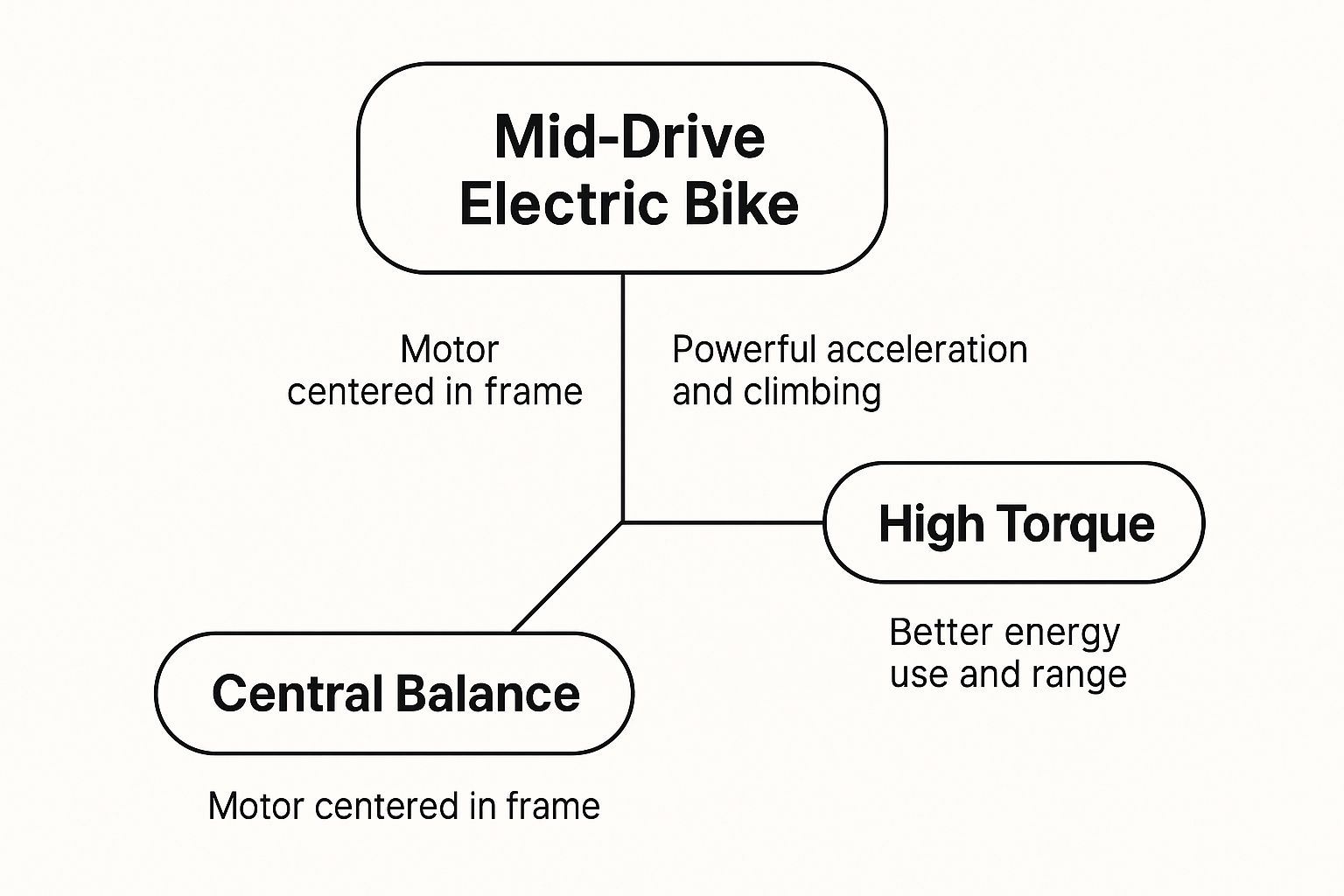
As you can see, it all comes down to how balance, torque, and efficiency team up to give you a ride that feels less like a machine and more like an extension of yourself.
A mid drive electric bike doesn't just feel like a bike with a motor bolted on; it feels like a stronger, more capable version of you. The power delivery is smooth and predictable, giving you the confidence to tackle any terrain.
This clever motor placement and gear integration bring some major benefits you'll feel on every single ride:
- Unmatched Hill Climbing: By tapping into the bike's own gears, the motor can stay in its sweet spot, churning out incredible torque to get you up the steepest climbs without even breaking a sweat.
- Superior Balance and Handling: Sticking the motor's weight at the bike's lowest, most central point creates a rock-solid center of gravity. This makes the bike feel nimble and firmly planted, especially when you're leaning into corners.
- Enhanced Battery Efficiency: Because the motor can use the gears to stay in its most efficient RPM range, you get more miles out of every charge compared to a lot of hub-drive systems. More range, more fun.
Mid Drive vs Hub Drive at a Glance
To make it even clearer, let's put the two main types of e-bike motors head-to-head. This table gives you a quick snapshot of where each one shines.
| Feature | Mid Drive Motor | Hub Drive Motor |
|---|---|---|
| Power Application | At the crank, leveraging the bike's gears | Directly to the front or rear wheel hub |
| Hill Climbing | Excellent; uses gears for high torque at low speeds | Good, but can struggle or overheat on very steep, long climbs |
| Weight Distribution | Low and central, providing a balanced and natural ride feel | At the front or rear wheel, which can affect handling |
| Efficiency & Range | Generally higher due to optimal motor RPM via gearing | Can be less efficient, especially outside of its ideal speed range |
| Maintenance | Changing a tire is easy, like a regular bike | Can make tire changes more complicated due to wiring |
| Cost | Typically higher initial cost | Generally more affordable |
While hub drives are fantastic for their simplicity and cost-effectiveness, the mid-drive's integrated, high-performance feel is what wins over riders who demand the best possible experience on varied terrain.
How Mid Drive E-Bikes Actually Work
Ever wonder what’s happening inside a top-tier mid-drive e-bike that makes it feel so incredibly smooth and powerful? You can forget about complicated engineering diagrams; the idea behind it is actually pretty straightforward.
Think of it like having an invisible friend giving you a perfectly timed, gentle push right on the pedals exactly when you need it. That’s pretty much what your mid-drive motor is doing.
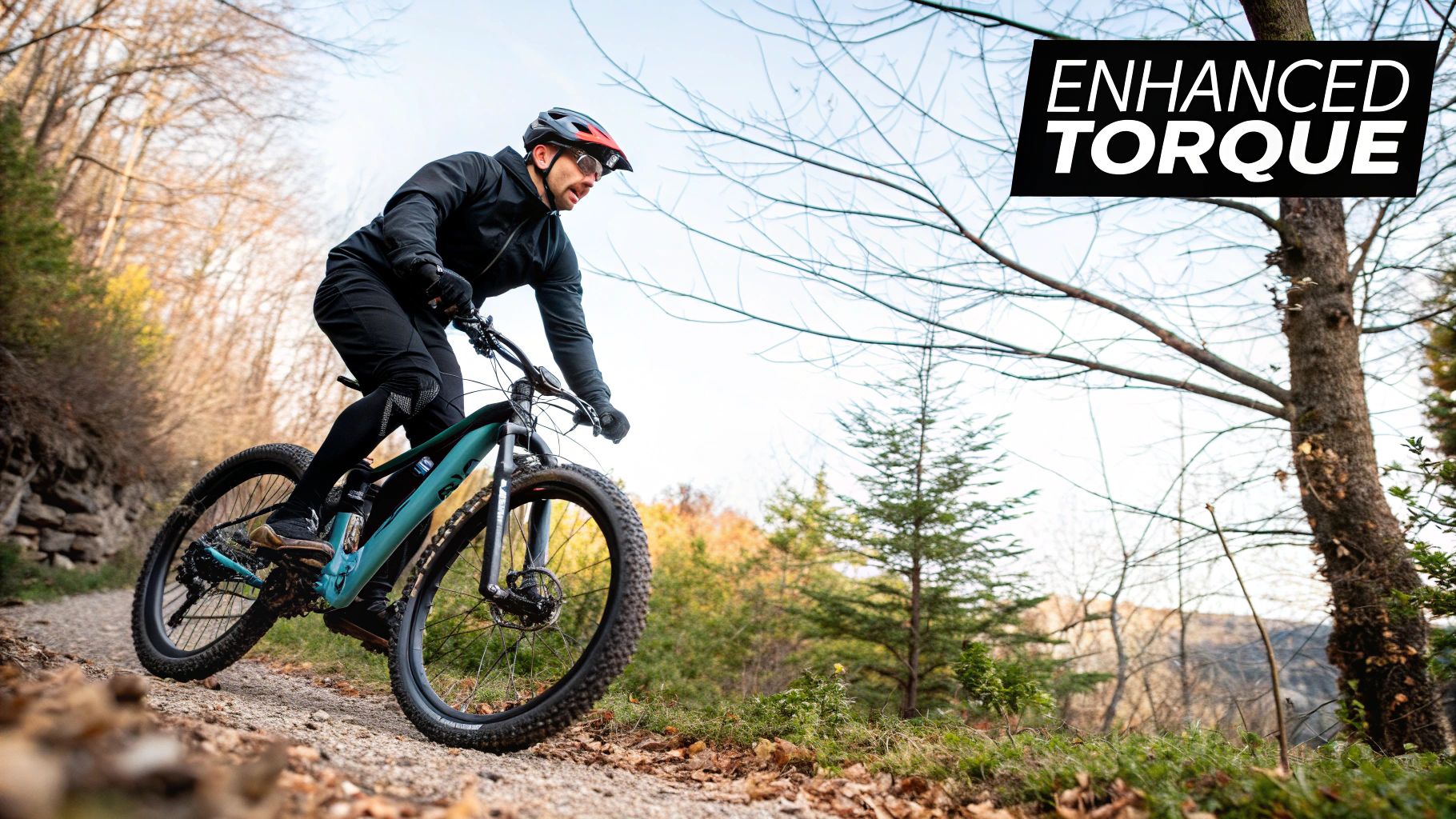
Unlike hub motors, which are stuck in one of the wheels, a mid-drive motor sits right in the middle of the bike's frame, down by the pedals. This central placement is key. It means the motor sends its power directly into the drivetrain—the same chain and gears you use. This little detail is the secret sauce behind its amazing performance and why it feels so natural to ride.
Because the motor is hooked into the drivetrain, it gets to use your bike's gears, just like you do. When you click down into an easier gear for a steep hill, the motor effectively does the same. This synergy keeps the motor spinning in its sweet spot, delivering maximum power without getting bogged down, overheating, or draining the battery. It’s exactly why mid-drive bikes are the undisputed kings of climbing hills and getting more miles out of every charge.
The Brains Behind the Brawn
A powerful motor is only half the equation. The other half is how it knows when to help and how much power to deliver. This is where sensors come in, and they are what separate a good e-bike from a great one. You'll generally find two types.
-
Cadence Sensor: This is the simpler of the two. It just checks to see if the pedals are moving. If they are, the motor turns on. It’s a bit of an on/off switch—pedal, get power; stop, no power. It doesn't care how hard you're actually working.
-
Torque Sensor: Now this is the smart stuff. You'll find a torque sensor on the best mid-drive electric bike models. It measures precisely how much force you're putting into the pedals. Pushing gently for a cruise along the flat? You'll get a little nudge of assistance. Stomping on the pedals to get up a monster hill? The motor instantly matches your effort with a powerful boost.
A torque sensor is what makes a mid-drive e-bike feel like it's reading your mind. The assistance is directly proportional to your effort, which creates this incredibly seamless ride where you just feel like a stronger version of yourself.
This intuitive response completely changes the riding experience. It gets rid of that jerky, all-or-nothing lurch you can get from simpler e-bikes. Instead, the power comes on so smoothly you might just forget the motor is there. You just feel like you’re having a fantastic day on the bike. This intelligent power delivery is a huge reason why riders everywhere, from the US to Australia, are choosing mid-drive systems for a truly premium ride.
What This All Means For Your Actual Ride
Specs on a page are one thing, but how a bike feels on the road or trail is what truly matters. The real magic of a mid-drive e-bike is how all that engineering translates into real-world advantages you'll notice from the very first pedal stroke.
Let’s picture two riders, Alex and Ben, hitting a steep, winding climb. Ben’s on a hub-drive e-bike. The motor is definitely pushing him along, but it feels a bit disconnected, like the bike is just dragging him up the hill. When the incline gets really nasty, the motor starts to strain.
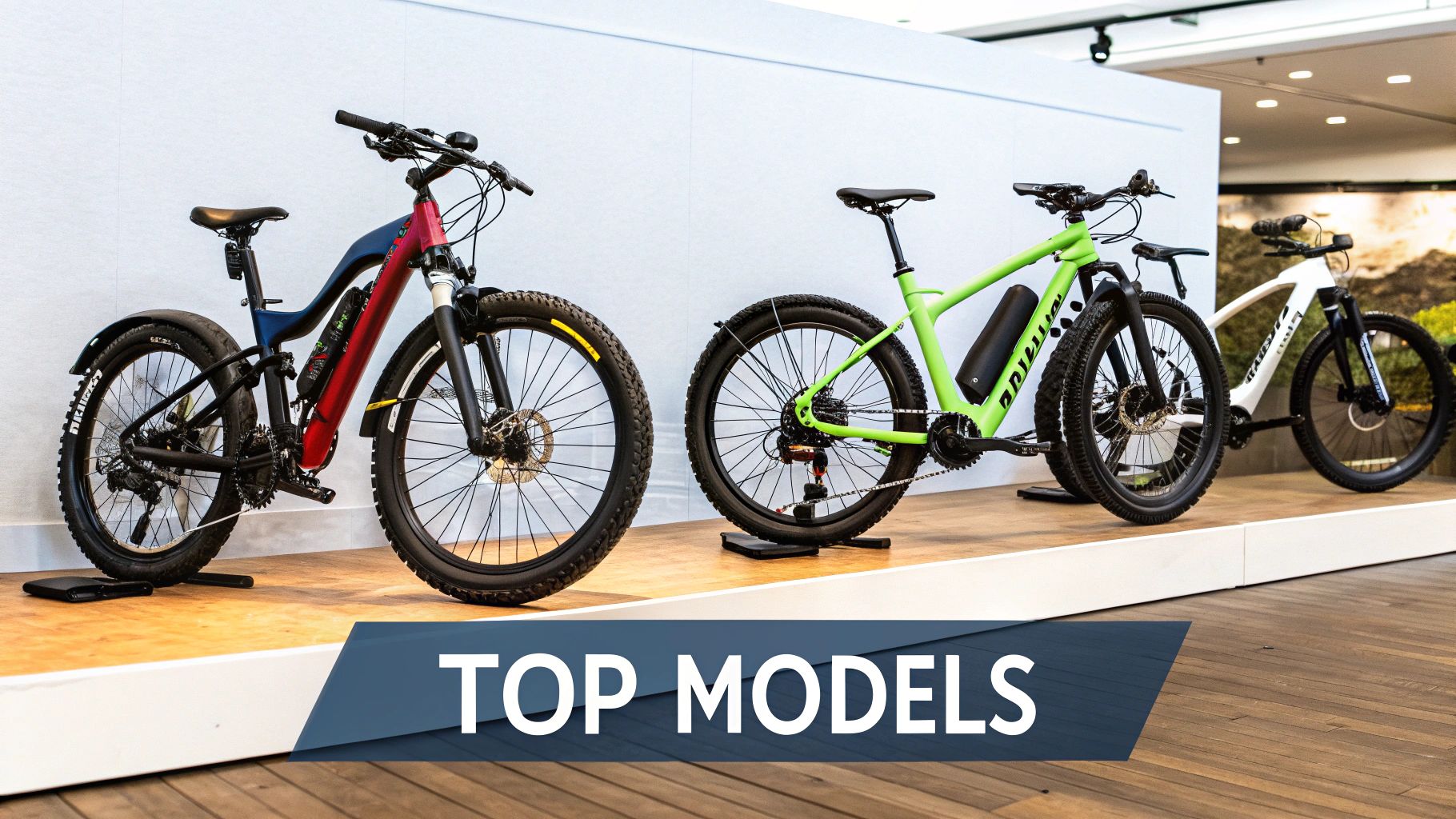
Now, Alex is on a mid-drive, and it's a completely different story. As Alex clicks down into an easier gear, the motor's power delivery changes right along with it. The torque feels smooth and powerful, flowing right through the pedals. It's like a natural extension of Alex's own strength, turning a grueling climb into something challenging but totally doable. That’s the core of it: intuitive power and total control.
It Just Feels Right: Superior Balance and Agility
One of the first things you'll notice is the incredible balance. Placing the motor's weight low and centered in the frame is a game-changer for the bike's center of gravity. This might sound like a small technical detail, but it makes the bike feel incredibly planted and stable.
Whether you're dodging potholes in the city or leaning into a fast turn on a dirt trail, the bike feels nimble and responsive—never top-heavy or clunky. This kind of stability gives you the confidence to ride more aggressively and, ultimately, more safely. It's no wonder the global mid-drive e-bike market is expected to rocket to USD 15 billion by 2033, growing at a healthy 8.5% clip. People are catching on. You can read more about the mid-drive market's impressive growth if you're curious.
The best compliment you can give a mid-drive e-bike is that you sometimes forget the motor is even there. It just feels like you, but on your best day ever, riding a bike that handles like a dream.
Go Farther, Worry Less
That smart motor placement also works wonders for your battery life. Because the motor works with your gears, it can stay in its sweet spot—its most efficient RPM range—way more often.
- More Miles, More Fun: This means you'll squeeze more distance out of every charge. Say goodbye to "range anxiety" and hello to bigger, bolder adventures.
- Smarter, Not Harder: The system isn't just dumping power inefficiently. This is especially obvious on hilly rides with lots of ups and downs. If you're serious about conquering inclines, our guide on the best electric bikes for hills is a must-read.
And finally, there's a simple, practical perk that every cyclist will appreciate: maintenance is so much easier. Get a flat tire? No problem. The motor isn't tied into the wheel hub, so you can pop the wheel off just like on a regular bike. No messing with wires, no complicated disassembly. It’s a small thing that makes a huge difference.
What to Look For When Buying a Mid Drive E-Bike
Alright, so you’re sold on the idea of a mid-drive e-bike and you're ready to pick one out. It’s easy to get bogged down in a sea of technical specs, but let's cut through the noise. Choosing the right bike isn't just about color and style; it's about understanding a few key numbers that really define how your bike will feel on the road or trail.
Think of this as your no-nonsense checklist. We'll focus on the handful of specs that actually matter, so you can compare bikes with confidence and make a smart choice.
The Power Players: Motor Torque and Battery Capacity
When you're looking at a motor's spec sheet, the first number you should hunt for is torque, measured in Newton-metres (Nm). Forget watts for a second—torque is the raw, twisting force that shoves you up a steep hill from a dead stop. It's the grunt.
A higher Nm number means more muscle for climbing. For most commuters and anyone dealing with rolling hills, a motor pushing out 50-70 Nm will feel fantastic. But if you’re planning on tackling seriously steep off-road trails or hauling a lot of cargo, you’ll want to look for something in the 85 Nm or higher range.
Next up is the battery, which is basically your e-bike's gas tank. Its capacity is measured in Watt-hours (Wh), and the concept is simple: a bigger Wh number means more juice and longer rides. Most mid-drive bikes come with batteries between 400Wh and 625Wh. That can translate to anywhere from 30 to 70 miles of range, but remember that terrain, how much power you use, and even your own weight will affect that number.
For those who need a bit more support, our guide on the best e-bike for heavy riders has some great recommendations.
Decoding Mid Drive Motor Specifications
To make sense of it all at a glance, here’s a quick breakdown of the numbers you'll see when you're shopping around. These are the specs that will tell you the most about how the bike will perform in the real world.
| Specification | What It Means | Good Range for Most Riders |
|---|---|---|
| Torque (Nm) | The motor's twisting power. Higher Nm = better climbing. | 50-85 Nm |
| Battery (Wh) | The "fuel tank" size. Higher Wh = longer range. | 400-625Wh |
| Voltage (V) | The electrical system's pressure. | 36V or 48V is standard. |
| Sensor Type | How the motor knows to help. | Always look for a Torque Sensor. |
Think of this table as your cheat sheet. When you're comparing two bikes, just pull up these numbers side-by-side to get a clear picture of their strengths and weaknesses.
Sensor Type and Brand Reputation Matter
We've mentioned it before, but it's worth saying again: a torque sensor is non-negotiable. It's the secret sauce that makes a mid-drive feel so smooth and intuitive, because it matches the motor's output to your pedaling effort. A bike with a cheaper cadence sensor just knows if you're pedaling, not how hard, which can lead to a jerky, unnatural ride.
Finally, let’s talk about brands. For anyone riding in the US, Australia, the UK, or the EU, sticking to the big names is a huge deal for reliability and long-term support.
Choosing a bike with a motor from a major brand like Bosch, Shimano, or Brose is like choosing a car with a well-known engine. You're not just buying performance; you're buying peace of mind, global support, and easily accessible spare parts.
These companies have massive service networks, so your local bike shop can actually diagnose problems and get you parts. With a lesser-known brand, you might save a few bucks upfront, but you could be totally stuck if something goes wrong down the line. Trust me, picking a reputable brand is one of the most important things you can do to ensure you'll love your bike for years to come.
Understanding Global E-Bike Regulations
So you've found the perfect mid-drive electric bike, and you're ready to pull the trigger. Hold on a second. Before you hit "buy," you need to know the rules of the road in your own backyard.
An e-bike that's perfectly legal on a bike path in California might get you a hefty fine on a cycleway in Sydney. Getting this right from the start means you can actually enjoy your new ride without looking over your shoulder.
The laws can seem like a confusing patchwork at first, with every country—and sometimes even states or cities—having its own take on motor power, speed limits, and throttles. Let's break it down for the US and Australian markets.
The United States Class System
Over in the United States, things are quite flexible. The US uses a three-class system that gives riders more choice when it comes to power and how they use it.
- Class 1: This is your classic pedal-assist bike. The motor helps you out as you pedal, but it cuts off at 20 mph. No throttle here.
- Class 2: These bikes also top out at 20 mph, but they come with a throttle. This means you can get a boost without pedaling, which is great for getting started at a traffic light.
- Class 3: This is the speed demon of the group. It's pedal-assist only (like Class 1), but the motor keeps helping you all the way up to 28 mph.
These classes aren't just for show; they dictate where you're allowed to ride. Class 3 bikes, for example, are often restricted from multi-use trails where you might find walkers and slower riders.
Australian E-Bike Laws
Down under, Australia takes a page from the European playbook but adds its own little twist. To be street-legal, an Aussie e-bike must have a motor limited to 250 watts of continuous power.
Where it differs is the throttle. Unlike in the EU, Australian law allows for both pedal-assist and throttle-powered systems, as long as the motor's power stays within that 250W limit and cuts off at 25 km/h. It’s a nice bit of flexibility for riders there.
The bottom line for the US and Australia is simple: know your local laws. Especially in the US, rules can vary state by state, so always check what's permitted on your local paths and roads.
A Note on UK and EU Regulations
For our readers in the United Kingdom and European Union, things are more standardized. To be considered a legal e-bike (and not a moped), your ride needs to meet the Electrically Assisted Pedal Cycles (EAPC) rules: a 250-watt motor limit, a 25 km/h (15.5 mph) assist cutoff, and pedal-assist only (no throttles).
When a Mid Drive Might Not Be the Best Choice
Look, as much as I'm a fan of mid-drive motors, I'll be the first to tell you they aren't the perfect fit for every single rider. It’s easy to get caught up in the hype, but let's be real—sometimes, a mid-drive is simply overkill. To make sure you get the right bike for your ride, it’s crucial to look at the other side of the coin.
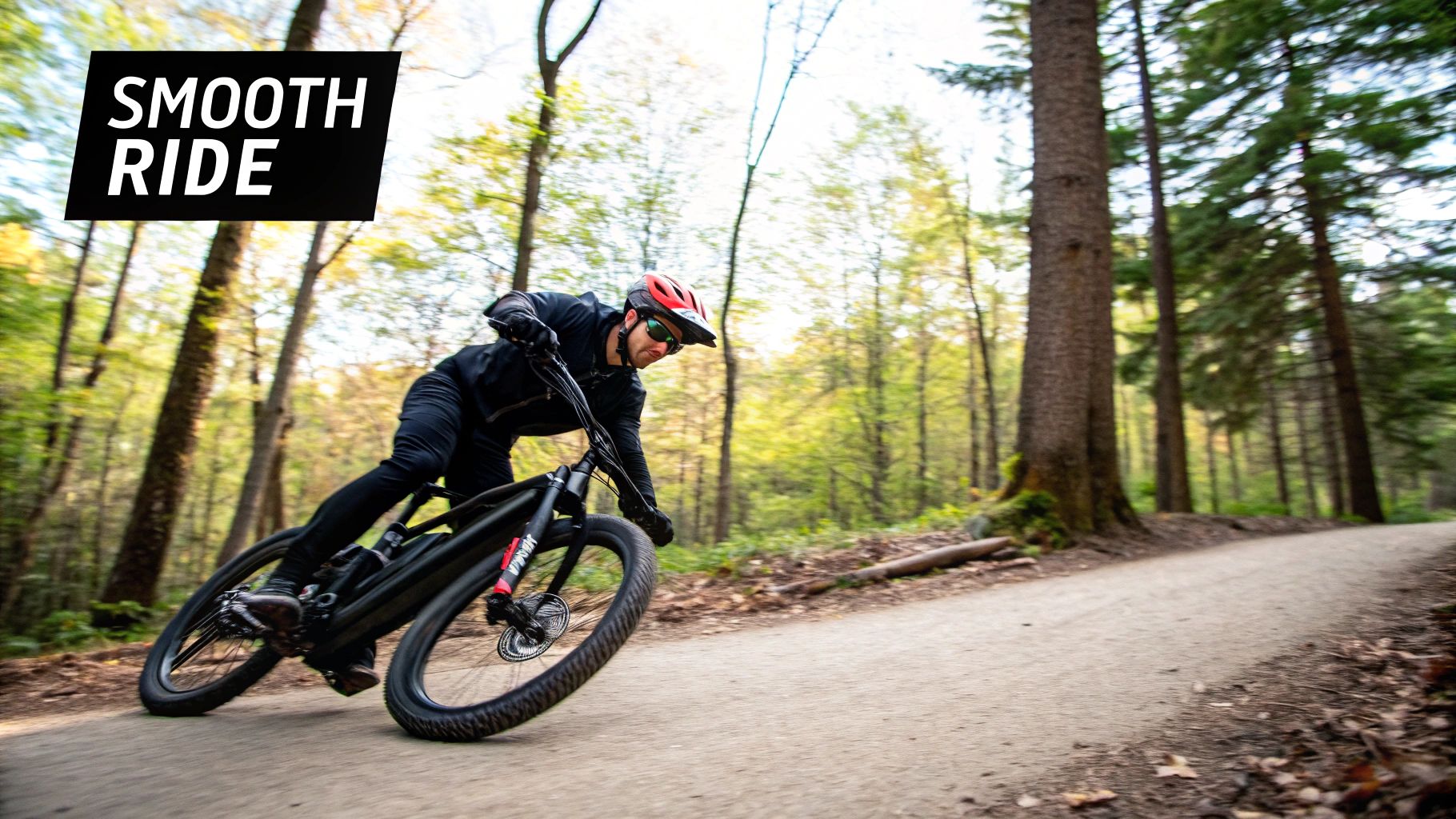
The biggest hurdle for most people? The price tag. There’s just no getting around it—mid-drive e-bikes almost always cost more than their hub-drive cousins. That extra cash goes into more complex engineering and sophisticated parts, but if your budget is a major factor, that initial cost can be a deal-breaker. We've actually got a great guide on the best electric bike under 2000 if you're looking for more budget-friendly options.
Another thing to keep in your back pocket is the wear and tear on your drivetrain. Because all that motor power is running right through your chain and gears, those parts are going to wear out faster. Period. This means you’ll likely be swapping out chains and cassettes more often, which adds to the long-term cost of ownership.
When a Hub Drive Makes More Sense
So, when is a simpler, more affordable hub motor the smarter play? It really comes down to how and where you ride.
A hub drive might be the better call if:
- You ride mostly on flat ground: If your daily commute is a mellow cruise on city streets without any monster hills, the awesome climbing power of a mid-drive is a feature you'll pay for but rarely use.
- Your budget is the main event: Hub motors are the undisputed champs of value. They can get you out on the road on a quality e-bike for a whole lot less money.
- You want a "set it and forget it" bike: With a hub drive, your chain and gears aren't under nearly as much stress. That translates to less maintenance and longer life for those parts.
At the end of the day, the best mid drive electric bike is an incredible piece of technology. But its real magic comes alive on hilly, demanding terrain. For casual rides on flat ground, a hub motor will give you a fantastic experience without the extra cost and upkeep.
Answering Your Top Mid Drive E-Bike Questions
Even after you get the hang of how mid-drives work, a few practical questions always come up. We hear them all the time, so let's get you some clear, straightforward answers.
These are the details that really matter when you're zeroing in on the right bike.
How Much More Expensive Is a Mid Drive Electric Bike?
You can expect a mid-drive e-bike to cost anywhere from a few hundred to over a thousand dollars more than a hub-drive bike with similar specs. It’s a noticeable jump.
That price difference comes down to the more sophisticated motor, the integrated torque sensors, and the fact that the bike's frame has to be specially designed to house it all. For most riders, the incredible performance boost and natural ride feel, especially on hills, make it money well spent.
Do Mid Drive Motors Require More Maintenance?
The motor itself? Not really. Big-name brands like Bosch or Brose seal their motors up tight, and they're built to last without much fuss.
The real difference is how a mid-drive motor interacts with your bike’s chain and gears. Since all the power goes through the drivetrain, those parts are under more strain and will wear out a bit faster than on a hub motor bike.
Keeping your drivetrain clean and lubed is key. You might find yourself replacing a chain a little more often, but the upside is huge: fixing a flat tire is a breeze because the motor isn't in the wheel hub.
Can I Convert My Regular Bike to a Mid Drive E-Bike?
You bet! It’s an incredibly popular way to go. Mid-drive conversion kits, especially from brands like Bafang, let you add a motor to a bike you already know and love. It can be a great way to get mid-drive performance without buying a whole new e-bike.
The main thing to remember is that it’s not just a plug-and-play setup. You’ll need a bit of mechanical know-how to get it installed, and you absolutely have to check that the kit will fit your bike's frame and bottom bracket before you buy it.
At Punk Ride LLC, we're passionate about helping you find the perfect electric ride for your adventures. Explore our curated selection of top-tier e-bikes and e-scooters from the best brands in the business. Find your next ride at Punk Ride today!
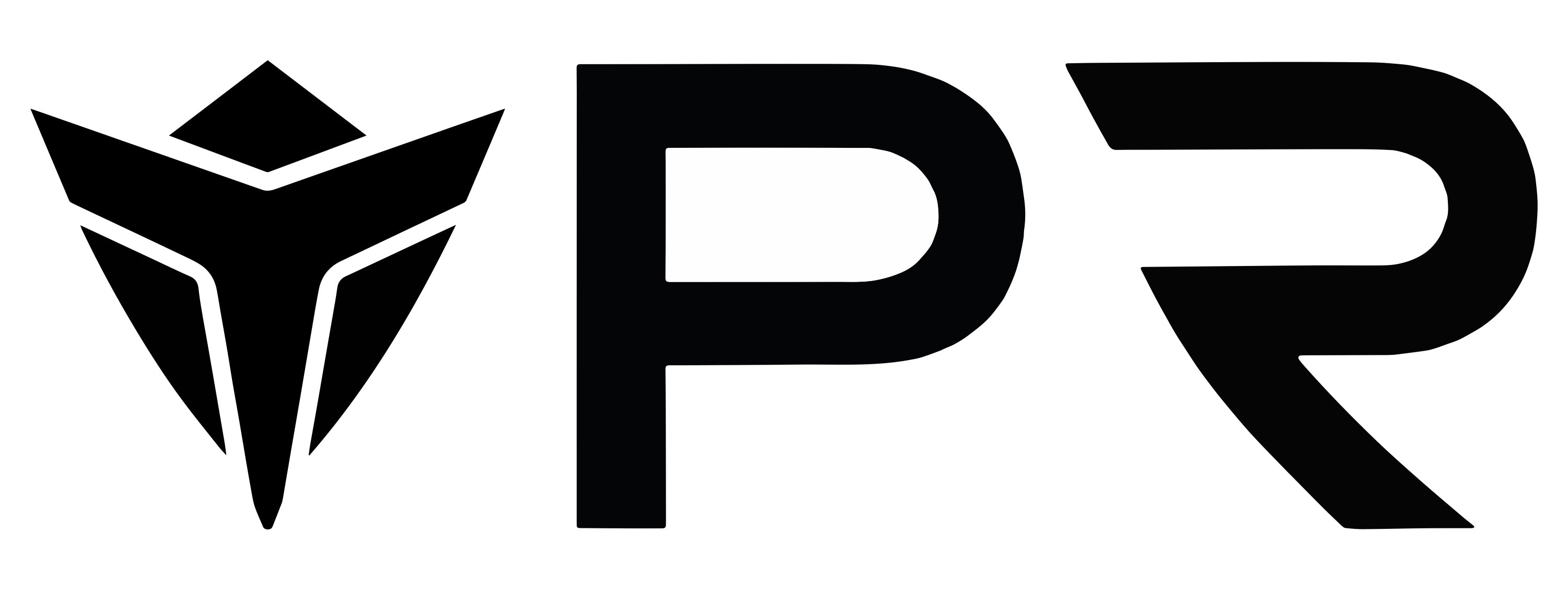
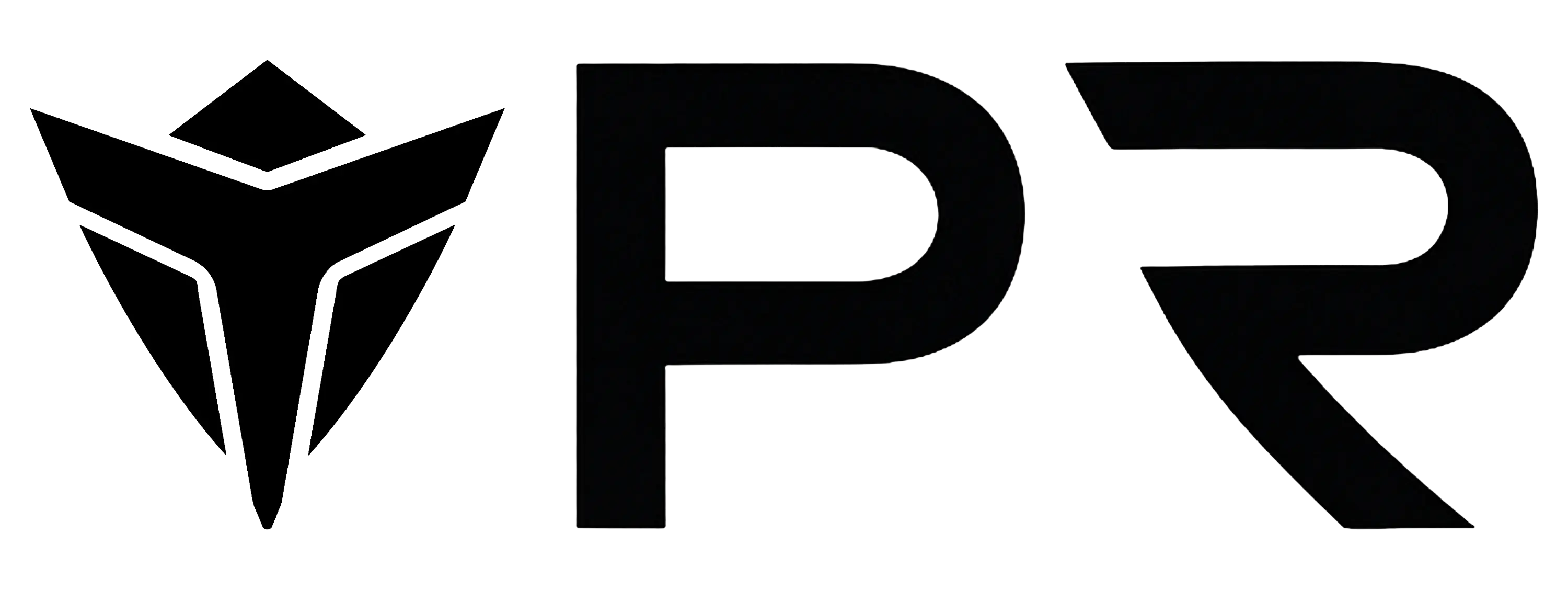


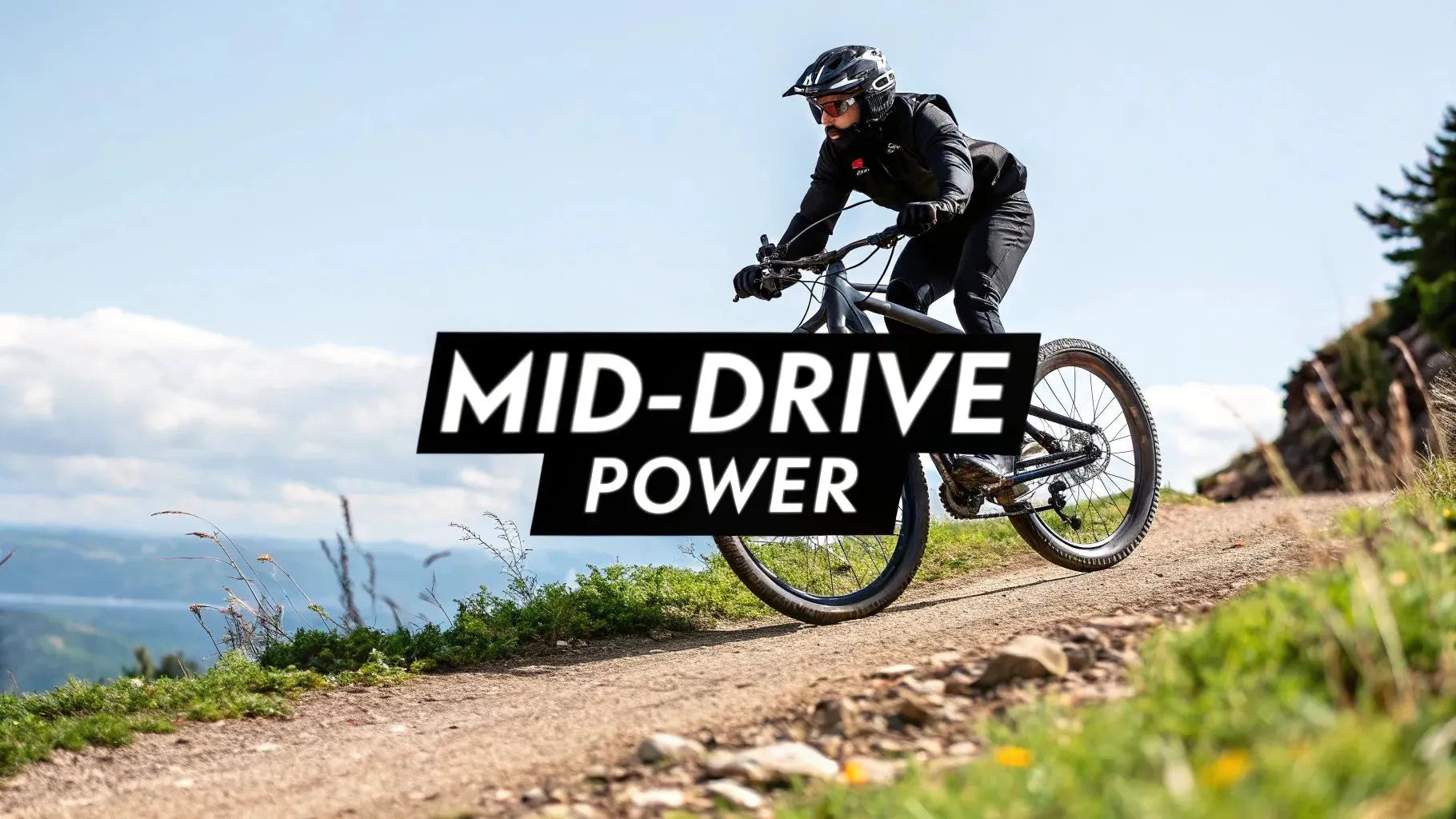
Share:
Top 10 Best Electric Bike Under 2000 Pounds in 2024
Your Guide to the Best Electric Bike Accessories